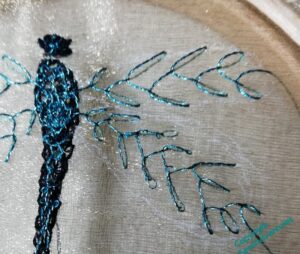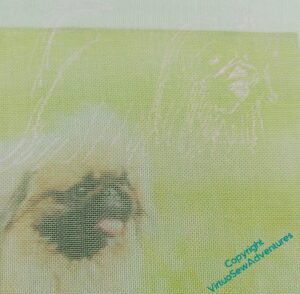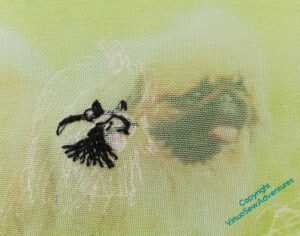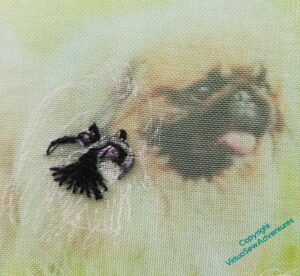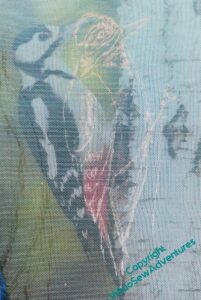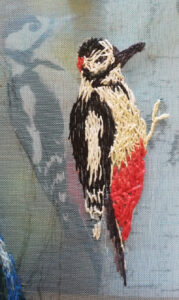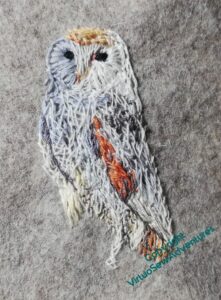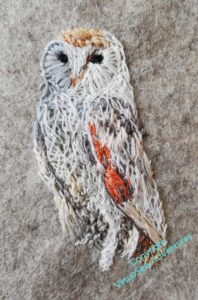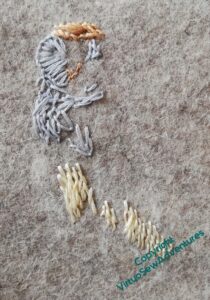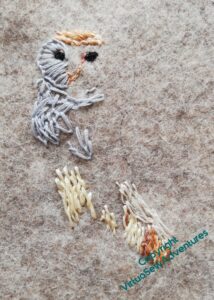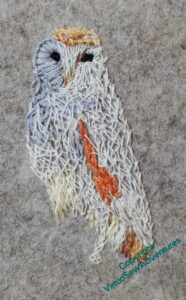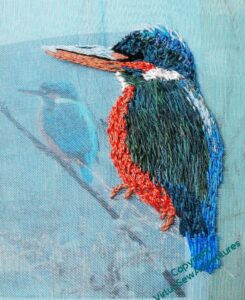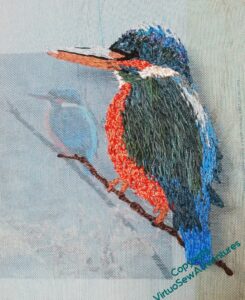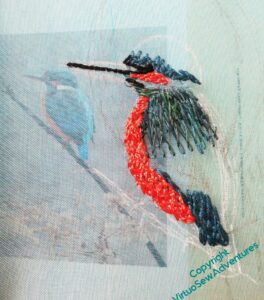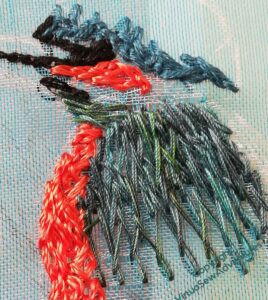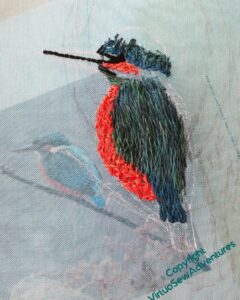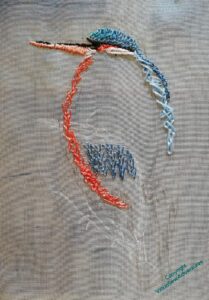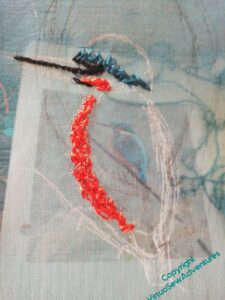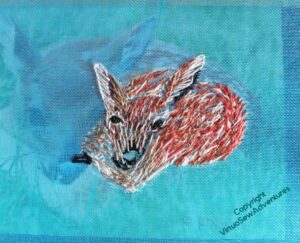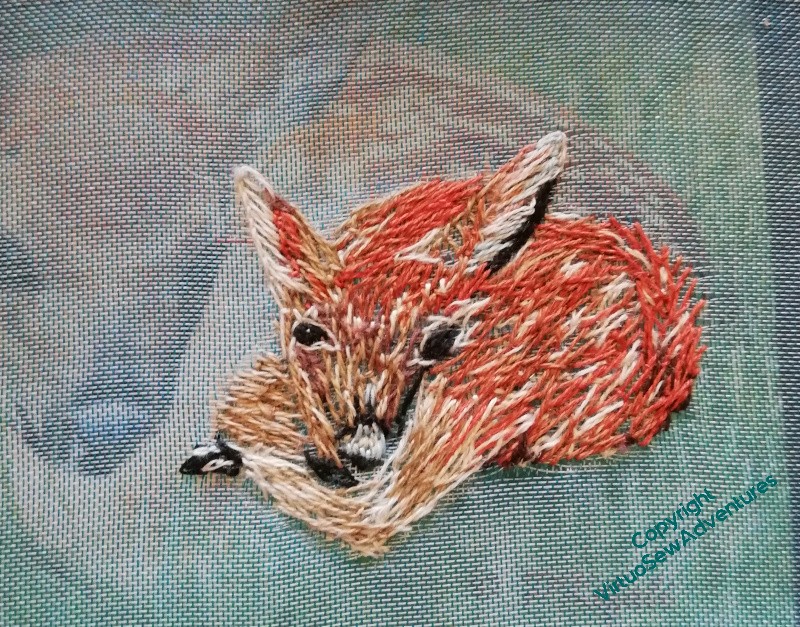Tag: experiments
Dragonfly – first trial..
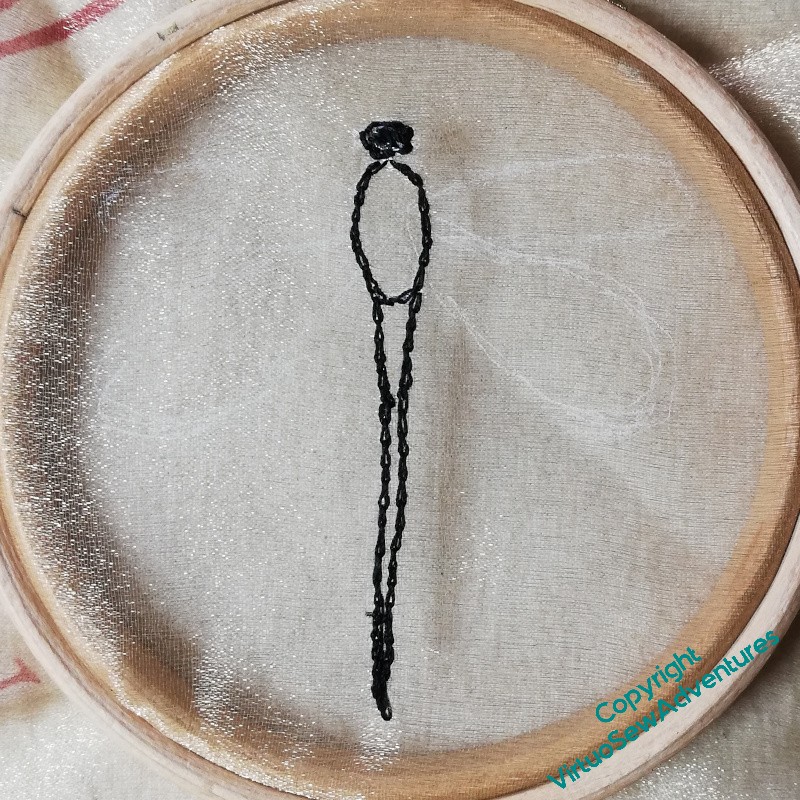
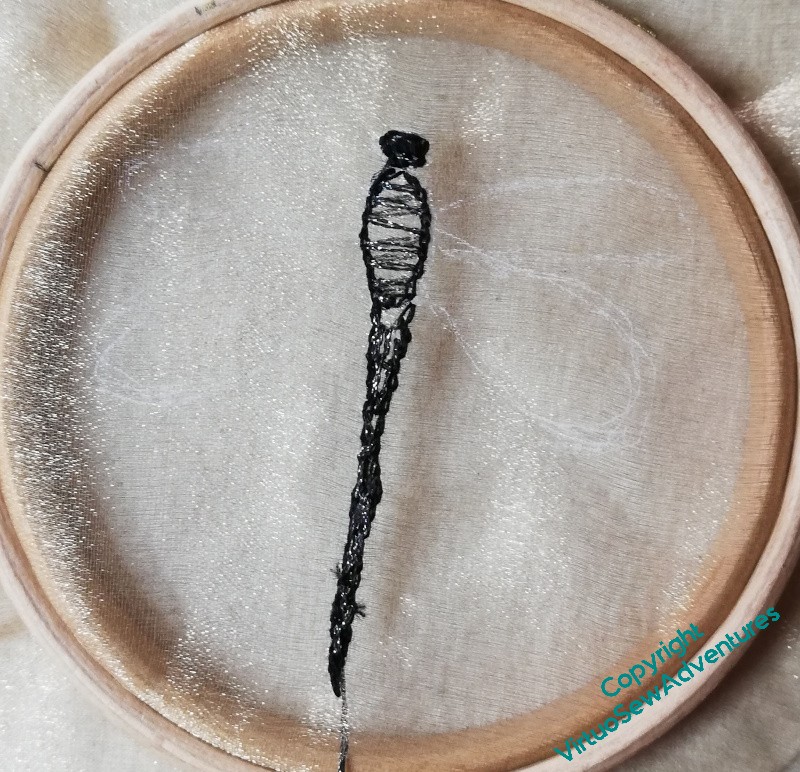
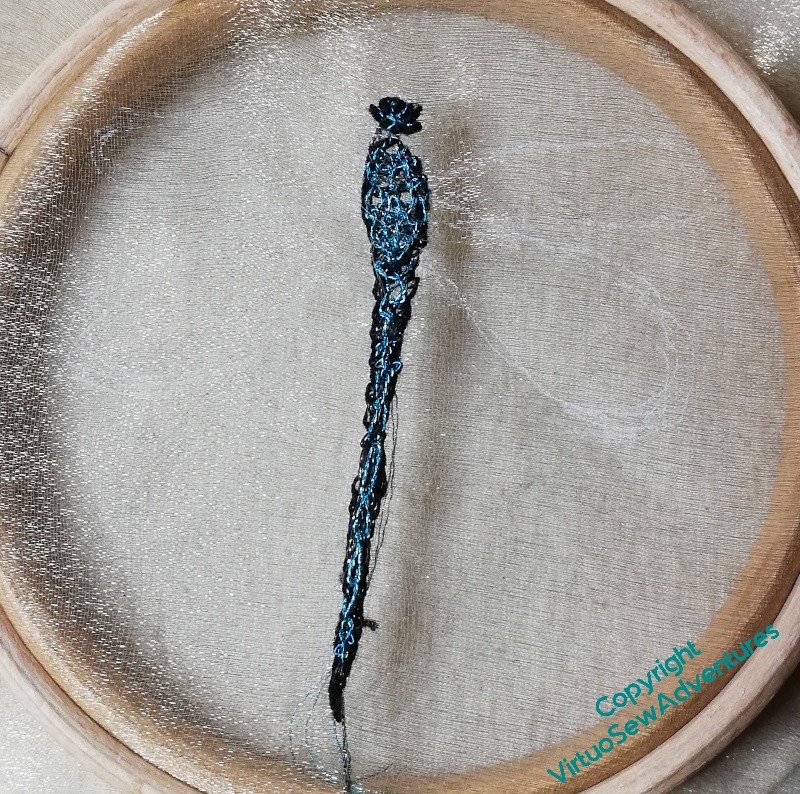
I find dragonflies and damselflies absolutely enchanting. I’m not entirely sure that I’ve got the right sense of delicacy and enchantment here – the threads are a little clunky, maybe, and the metallic thread wants a conditioner or something else to protect it as I work. I wanted to use a longish thread so that I didn’t have lots of tyings-off, but that just meant more opportunity for tangles.
I outlined the body and then worked straight stitches across in a dark metallic thread. The intention was to work needlelace type stitches in the coloured thread, catching into the dark straight stitches. The idea was that that would modify the colour slightly.
It has worked after a fashion, and the feather stitch veins on the wings also work after a fashion. But not quite.
I need to think of ways to finish off the veins in the wings so the stitches don’t unravel – glue? fraycheck? enclosure?
And I think I maybe need to do it again, smaller, and using a single strand.
Mary The Pekinese again
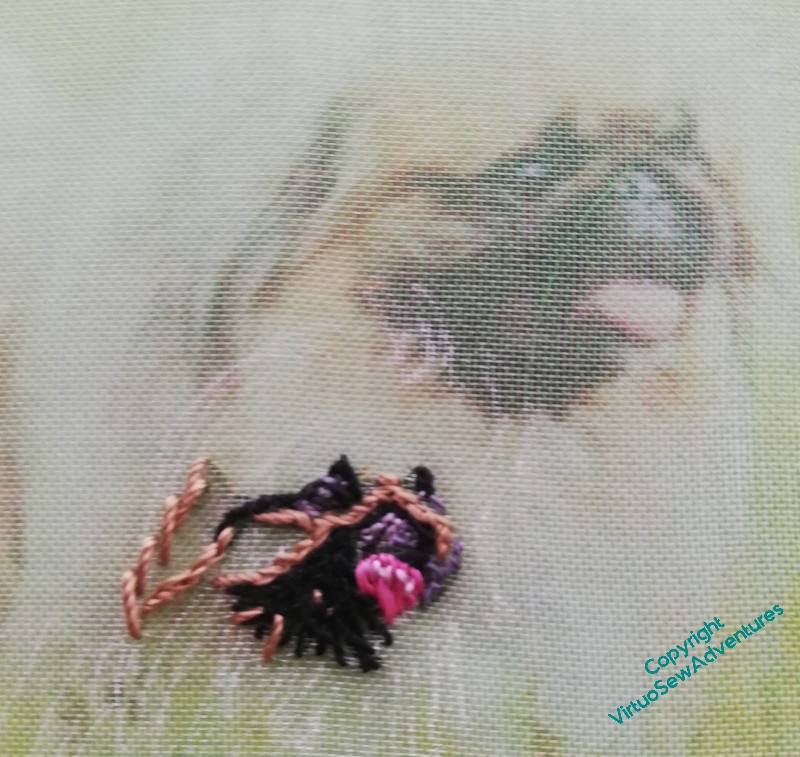
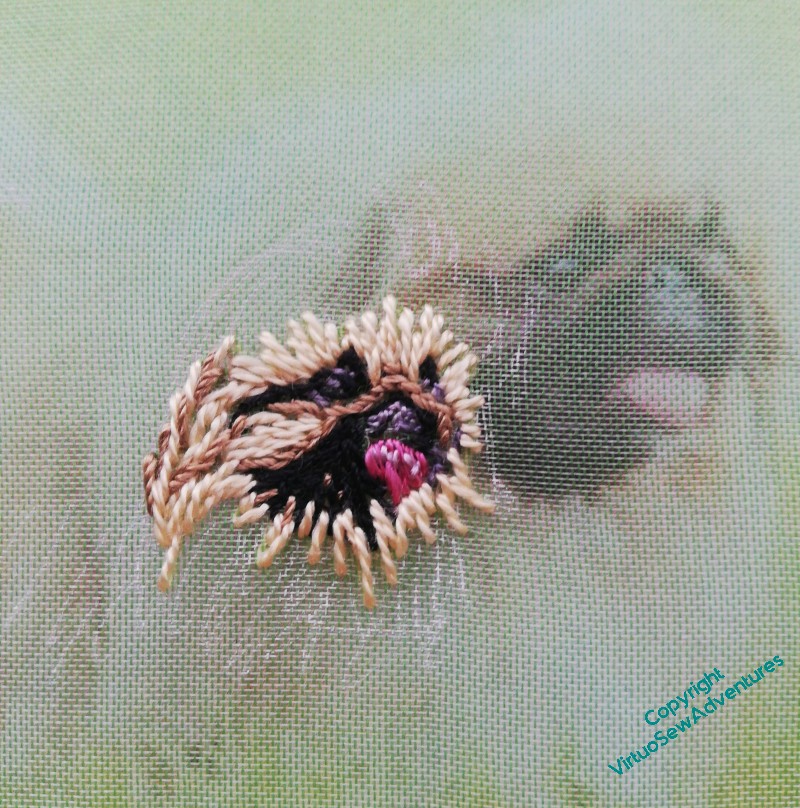
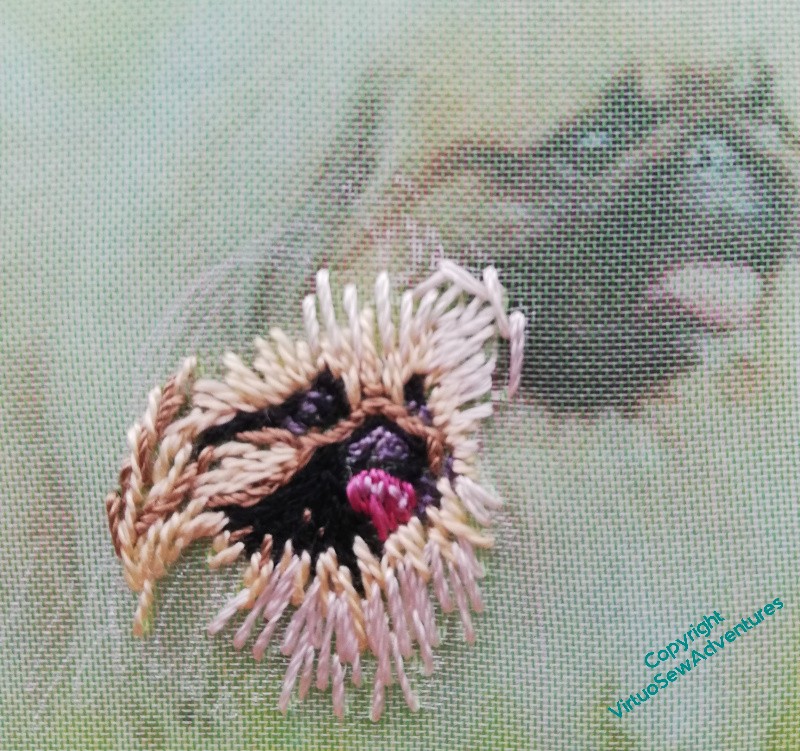
It’s quite hard to explain what I mean by the improvisatory, painterly approach I’m using for the assorted Animal Vignettes for the Conversion of Placidus project, so since Mary the Pekinese is relatively simple compared with some of the others – mostly straight stitches, rather than the tangle of Cretan I used, for example, for the little rabbit, I thought maybe a sequence of photos was the best way to show you what happens.

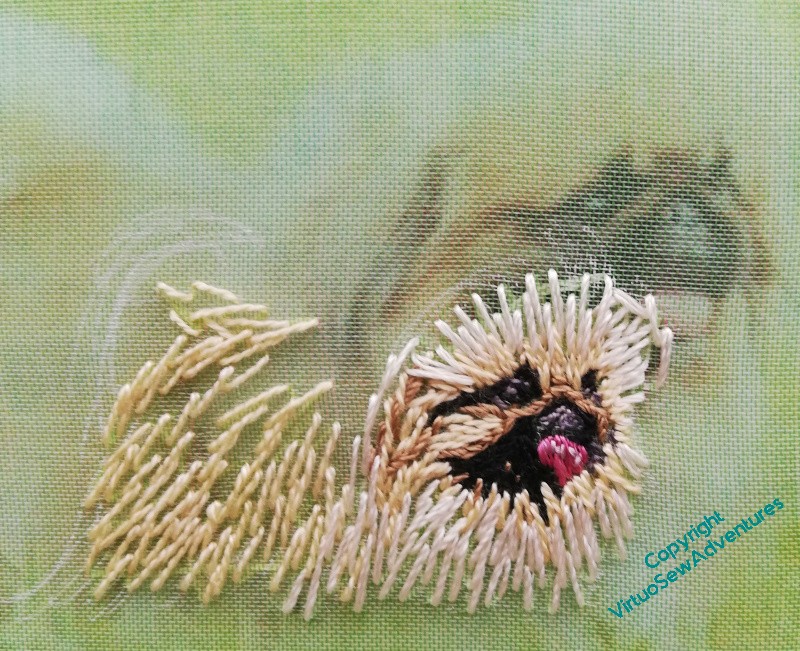
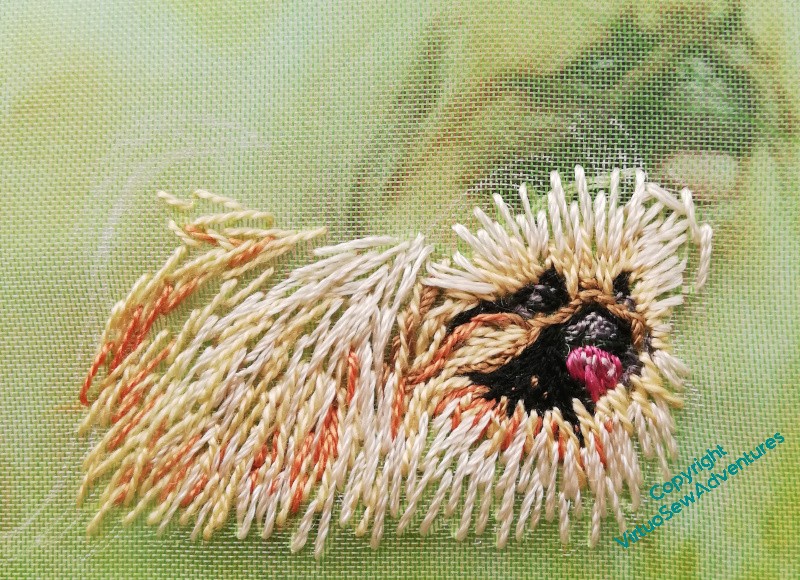
In each case I’ve put the frame on top of the photo I’m using. The finer, subtler details of the fur don’t really show through the gauze, but it does give you some sense of how I am selecting my threads to capture the impression of colour and texture that I’m working from. I’m not concerning myself at all with what fibre the thread is made from – if it does what I want it to do, I’m using it.
I’m also recollecting a quotation I found, attributed to the painter Edgar Degas : “If it were not difficult, it would not be fun!”
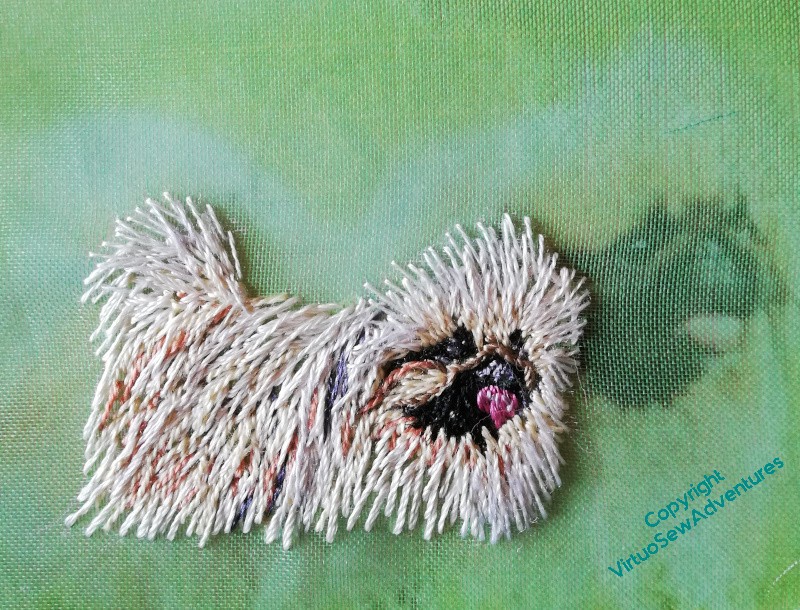
Worth the effort, though. I do think she’s turned out rather well!
Starting Mary the Pekinese
Now, although the starting impulse for the Placidus panel is the Pisanello painting (and I will be saying more about that in another post), it is also Elizabeth Goudge’s story, woven around an imagined version on an ancient wall. In the book, “The Herb of Grace”, the painting is already in the air, in your mind as you read, long before the mischievous young twins start pulling wallpaper off the pantry wall to reveal an ancient fresco.
So although I’m not intending any humans other than Placidus himself to be in the painting, the family dogs are definitely going to be in there, and I am starting with Mary the white pekinese.
And here we go again – the sketchiest of outlines, a piece of gauze, and the sort of breathless pause you take when you Definitely Don’t Want To Ruin It.
As you can see, the stitched version isn’t the same size as the source photo, so I can’t quite lay the gauze over the top to find where to stitch, but I can compare the shapes I’m creating. The black thread (good grief, I’m using black thread!!) is a fine silk, as used on the woodpecker.
The grey thread here in the highlights is from a gorgeous variegated silk eight strand thread. I think I may have bought it for “Leaving The Tyne“, but to be honest, at this stage I have no idea! It’s going to be useful, though, because I have several shades to pick from within a single length..
And I am already startled by how well Mary the Pekinese is looking.
There’s going to be a woodpecker, too..
I am going to start rereading the book again, at some point soon, but in the meantime, since I’ve rediscovered my “Vision of Placidus” notebook, I know that one of the birds I was going to include is a woodpecker.
I’m going to have to go to the shops and find some more gauze soon, as well, but while I can squeeze an animal in to the existing fabrics, I will do so.
I’ve commented before, I think, that getting a readable and workable design drawing onto gauze is a non-trivial exercise, but this opaque white line (a Posca pen) is pretty much the best I’ve found so far, and it also allows me to help myself by putting a few extra emphases on the lightest parts.
It’s amazing how quickly these little animals go, once I have a chance to get started. In fact, I was so entranced by how Woody was growing that I didn’t stop to take photos. In fact, I barely stopped to draw breath.
So this photograph shows a single afternoon’s work. I’ve used mostly fine silk threads, although his red breeches are a soft perle, and some of the white is probably cotton. As for approach – I simply tangle my stitches together, feather stitch variations, Cretan stitch variations, the occasional chain stitch or straight stitch. What I’m hoping is that the tangle of stitches will create a subtle variation in colour that will help the whole thing feel alive when it’s viewed from a reasonable distance.

I didn’t have much I wanted to add, in the end. A few highlights, filling in the wings a little, and then really the woodpecker is done. I may add more when it comes to assembling the piece (remember all those seed stitches I added to the View of the Excavation once I started assembling the Dreams of Amarna panels?), but that can wait until I know what is being balanced with what.
I have been thinking, on and off, since I was asked about it after my talk, that assembling Placidus may prove to be an exceptionally challenging process. The panel I envisage is going to be about five foot by four foot, and I have a horrible feeling I’m going to be propping it against a wall or slinging it from hooks or even emulating one or other of the great Impressionists by somehow arranging a slot in the floor to drop it into while I tackle the top.
Maybe I shouldn’t be in too much of a hurry to finish this one…!
Finishing The Kingfisher
The kingfisher has been really quite tricky, but rewarding, too.
I do enjoy these colours, for a start, and the chance to use the really glossy rayon thread that helps his bright orange breast to shine. For the bright stripe of his back and tail, I’ve ended up combining threads in the needle to get just the colour I want. Even with a full range of Madeira stranded cotton in my thread stash, the precise colour and tone weren’t quite there. There’s another variegated mercerised machine thread in the mix as well – I think the motto for this piece is going to be “Whatever It Takes!”!
When I looked closely, I realised that the lower beak and the little claws were a very similar colour. The feet have been made a little scalier by stacking single twisted chain stitches atop one another so that they narrow into claws.
I’ve made the dark line of the beak narrower by bringing split stitches close in on either side, and done a lot of staring and adding little areas – the top of his head, the white flash at the side of the head, and the tiny bit of white at the throat. When I put him wherever he ends up, that will be one of the push-pull elements that helps him to detach sufficiently from the background to do his job.
Finally, I decided that the couple of bits of dark showing the underside of the far wing did in fact need to go in – more of the push-pull.
Then he wanted a twig to sit on. When I come to set him in place, I may cut some of the fabric close or turn it under, but other parts may be left so that the blue gauze modifies whatever is underneath. Some of this twig may be undone, some of it may be enhanced and extended.
I am reminding myself that I don’t work my best when I’m fretting about the Whole Thing. I do very much better when I get started and work out the whole thing later. I need to read the book again, to see whether there are particular animals I have to include. That will be no hardship, it’s a much beloved book!
I shall be giving a talk for the Embroiderers Guild on June 3!
I believe I’ve turned this image into a link to the Eventbrite page, and for anyone not in the right timezone, or otherwise occupied on the day of the talk, the Guild makes recordings available for some time afterwards.
I shall remind you every week until it happens!
The Kingfisher Continues
The kingfisher is proving more complex than some of the earlier animal vignettes. This is partly because the shape is complex, and partly, I think, because this is one of the elements I really want to include, so it’s hard to “play” quite so freely!
The lower stitching – part of the wings, maybe, or the tail? – is densely stitched in stranded cotton, and the head is small, tangled stitches again in stranded cotton. The original photograph that I’m using as a guide shows much smaller speckles of colour over the head, so the smaller stitches should help with that..
I’ve put a line down the beak which I need to make narrower as I stitch the rest of the beak, and I’ve started on the wing.
You can see in this close up that I’m using two strands of a variegated mercerised cotton for the wings, overlapping and tangling my Cretan Stitches to create something like the effect of the feathers. Considering that fluffy effect it has created for fur in some of the other Vignettes, I’m astonished and delighted that it’s not looking fluffy this time. The colour helps, of course, and the stitches are more closely packed, but still, I’d not realised until now just how versatile Cretan Stitch is!
I’m very pleased with progress so far. I need to find the right bright shade for that stripe down the back and the end of the tail, fit in his white collar, and the bright colour on the top of his head, and then work out how to keep the beak neat and crisp.
So far, that’s defeating me, so wish me success, please…!
A reminder that I shall be giving a talk for the Embroiderers Guild on June 3!
I believe I’ve turned this image into a link to the Eventbrite page, and for anyone not in the right timezone, or otherwise occupied on the day of the talk, the Guild makes recordings available for some time afterwards.
I shall (continue to) remind you every week until it happens!
And now for a kingfisher…
Many years ago – but after I first thought of doing a panel for the Conversion of Placidus – I went to a tour of Flag Fen, guided by Francis Pryor who had discovered and excavated it. As we strolled at the side of the fen, having much explained to us, there was a flash of bright orange, and a kingfisher shot across our bows. The effect, in glorious sunshine, with our minds in the Bronze Age, was absolutely electrifying, and I vowed that there would be a kingfisher in Placidus, somehow.
Of course, that’s easier said than done!
You maybe able to see in the first picture that I’d had two goes at drawing the Kingfisher, and started to embroider the larger one. I was intending him to be in the border, so I wanted him larger than a vignette. But that was not the way to do it, he’s too long in the body, and generally adrift. So I decided to go back to the first drawing, and not worry too much about leftover drawing.
It’s always sad to be unpicking, but once I’ve decided it’s necessary, I don’t repine, or even growl (much…). The next version will be better.
So I have started agin. The kingfisher’s breast is a tangle of overlapping feather stitch and feather stitch variation using Marlitt. It’s a good, vibrant colour, and I seem to have not had too trying a time with it, all things considered. Viscose threads such as Marlitt are very lively and twitchy, and if I want a smooth satin stitch, I try to damp out the kinks. For this, not so much, I want the light sparkling off the stitches, the speckles and high spots catching the light.
Well, it’s a start!
Now, a reminder that I shall be giving a talk for the Embroiderers Guild on June 3!
I believe I’ve turned this image into a link to the Eventbrite page, and for anyone not in the right timezone, or otherwise occupied on the day of the talk, the Guild makes recordings available for some time afterwards.
I shall remind you every week until it happens!
Finishing the Fawn
So, the Fawn…
Started, just like the rabbit, with a bit of pinky orange and a peculiar stitch choice (welcome to my world!).
Then I’ve continued, also just like the rabbit, by using Cretan Stitch, single strands, and some straight stitches. I’ve grouped some of the lighter stitches to help with the spots, I’ve put in the ears and hoof.
And the eyes. It does help, I think. These animals are being worked so freely, so approximately, if you follow me, that I need to find navigation markers to help me keep on track!
You will see that the finished Fawn isn’t quite right in all proportions, perhaps. The eyes aren’t balanced, and I’ve not managed to convey the narrow little face with its velvety fur.
But I’ve produced something that “reads” as a fawn, that is makes use of fabric and stitch, using the edges of blanket stitches to give me lines where I need them also to tie into the perpendicular direction. In a year’s time, I may come up with another way of doing this, but for now, I’m content.
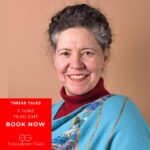
Now – a very exciting thing! – I shall be giving a talk for the Embroiderers Guild on June 3!
I believe I’ve turned this image into a link to the Eventbrite page, and for anyone not in the right timezone, or otherwise occupied on the day of the talk, the Guild makes recordings available for some time afterwards.
I shall remind you every week until it happens!


